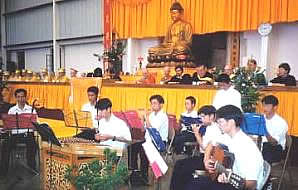
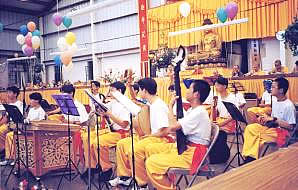
The story of the Development of Traditional Chinese music
Written by Agis Gan, DRBU/DVSS Chinese orchestra instructor
Traditional Chinese music developed through the ages, originating back in the ancient times. During the era of Zhou Dynasty (about 1111 BCE to 221 BCE) more than 3,000 years ago, Chinese civilization then had reached a zenith following the earlier Shang Dynasty (about 1600 BCE to 1111 BCE) and Xia Dynasty (about 2100 BCE to 1600 BCE). Pure instrumental music had already been created by the ancients. The spiritual perspective of the ancients was a unity between heaven (cosmos) and the human realm. Music was thus a medium of communication with heaven. For instance, the gu qin (an ancient zither) of the Zhou Dynasty measured 3 feet 6 inches and 5 minutes in length (in the old Chinese measurement system). It signified 365 days of a year, and a revolution of 365 degrees around the heaven (cosmos). The upper surface of the qin represented heaven while the bottom surface represented the earth, thus hinting the unity of heaven and the human realm. The different body parts of the qin were given names such as “golden boy head”, “jade maiden waist” and “fairy back”. Even up to today, these traditional features of the qin remain.
This ancient culture of unity of heaven and human realm continued through the period of Zhou, Qin, Han, Wei, Jin, Sui, until the Tang Dynasty (from 1111 BCE to 959 CE). Song Dynasty (959 CE to 1260 CE) and after, saw a disappearance of this culture. Music was relegated to human activity alone. From the Song through the Yuan, Ming and Qing Dynasties (from 959 CE to 1912 CE), the development of Chinese Buddhist, Taoist, and Confucian ceremonial music, imperial court music, folk, instrumental, voice, ballad singing, dance and opera music continued to progress along its path but with changes over time. The new trend of development that needs to be mentioned during this period is the path of diversification of multi-ethnicity, multi-locality, and from scholars to the general citizenry. History demonstrates that music was also a tie of friendship to the ancient intellectuals. Thus in Chinese literature, “one who knows the sound” carries the meaning of a close friend who knows your heart. This signifies the importance of music to the intellectuals.
From the 5th to the 15th Century, Europe was under the Dark Ages. Cultural activities and development was mainly centered in the church. The center of music was vocal sacred music of the church, created to praise and adorn the magnificence of God. The rise of troubadour poetic singing with instrumental accompaniment in the twelfth century was being categorized as secular. There was no record of pure instrumental music during this period. The Renaissance (1400 CE to 1600 CE) era saw the beginning of the exploration and development of pure instrumental music. It is believed that the spreading of the records of Marco Polo’s (about 1254 to 1324 CE) travel to China inspired the European musicians on this development. It is interesting to note that most scholars who study Chinese culture understand that from the era of the Song and Yuan Dynasties (959 CE to 1368 CE), Chinese operas and local musicals were highly developed. Bowed instruments became the main instruments to accompany operas and musicals. Meanwhile in Europe, the Baroque era (1600 to 1750) saw the beginning of the bowed instruments such as the violin, viola and cello, and also operas. This marked the foundation for the emergence of symphony orchestra and comic opera of the later Classical Period (1750 to 1800) and the captivating development of Romanticism (1800 to 1900) and 20th century phenomena.
The emergence of pure instrumental music in China during the Zhou Dynasty was due to the height of its contemporary bronze and silk technology. The bronze technology created the authentic bronze bell chime set. In 1965, unearthed artifacts from the tomb of Zen Hou Yi of Hubei Province included a bell chime set of 65 dual tone bells varying in sizes and encompassing a range of five octaves. This signified the technology of the 5th. Century BCE, was unprecedented and never ever seen again anywhere else. It is also unparalleled to the present age. The emergence of the gu qin (ancient Chinese zither with 7 strings) came forth from the discovery of silk. The making of high quality silk strings made it possible for the invention of the gu qin, which was also unprecedented. The eight sounds of the Zhou Dynasty consisted of eight instrumental families: metal, stone, silk, bamboo, gourd, ceramics, leather and wood. The sheng, a gourd family member, used the science of resonance vibration from a thin calibrated bronze tongue with the natural frequency of an air column in the bamboo tube right above. In Europe, this scientific principle of resonance effect in sound was unknown until the modern scientific and industrial revolution.
The inspiration of a highly developed Chinese culture and technology in the 15th century spread throughout Europe. It later sparked the beginning of international competition in exploring science. Furthermore, the industrial revolution which included America saw the gradual development of modern science and technology to the present day. While this was happening in the West, the Ming and Qing Dynasty (1368 to 1912) of China saw a period of slowing down in scientific and technological progress. With its vast land and rich resources, China was self sufficient. Without competition and revolution, or the need to explore as in Europe, China was quickly left behind in the advancement of science and technology.
The advancement in music theory and instrument manufacturing technology in the West was brought to China in the past 100 years. Under the impact of this surging current, the Chinese began to internationalize their traditional music by unifying the essence of both Chinese traditional and Western musical culture, bringing it to another climax. Historical China had adopted varied application of tonal scales. Also there were not too many differences in both contemporary musical cultures; the Chinese began to adopt the Western chromatic spectrum and internationalized their instrument calibration. So, the differences in the instruments now are just the cultural outlook and their tonal colors. Other differences in the structure of the Chinese and Western orchestra are mainly cultural and choice. As a result, both the Chinese and Western orchestras could tailor their music scores to perform music of both cultures.
In the past 100 years or so, there are four aspects of development in traditional Chinese music. First of all, Chinese music can be performed or accompanied by both traditional and Western orchestras. Second, Chinese music has incorporated Western concepts of orchestration such as texture, form, and style to strengthen and enhance its expressiveness. The most conspicuous aspect of orchestration effect is the inscription of vertical harmony (Western) in addition to its horizontal harmony (traditional). Third, even though the external form has evolved, all the inspiration and sources of creativity still carry the legacy of traditional music, imperial court music, and folk music. Fourth, new compositions by a new generation of musicians have preserved the distinctive features of traditional essence, colors and taste.
What is the essence of traditional Chinese music? Most Chinese scholars know that harmony is the essence. The interesting thing was no one had ever clearly talked about its harmonic structure. Recently, some Chinese musicologists rediscovered the following. They found that the ancients during the Zhou Dynasty had studied music in depth and chose “gong”, “shang”, “jue”, “zhi”, “yu” to construct five harmonic structures. In the Western sol-fa syllables, these are “do”, “re”, “mi”, “so” and “la”. The zhi harmony structure was “so – do – re – so”. It was most widely used. The structure of shang harmony was “re – so – la – re”, yu harmony “la - re – mi – la”, jue harmony “mi – la – do – mi”, and gong harmony “do – mi – so- do”. Together they formed a cyclic regenerating system that linked the five structures in a circle. After Zhou Dynasty the classic “Book of Music” was lost. No one knew if discussion about this harmonic system was recorded in this classic. In actuality, this harmonic system was musically implanted in the Chinese mind. It silently became the unwritten inspirational source for all music creativity, and it continued to today. The result was amazing. Though Chinese people are immensely diverse in their ethnicity and in differences due to localities, all Chinese music uses the same acoustical system of harmony. As a generalization, one can say that the Chinese people are unified by the same harmony system in music, in addition to the same calligraphy in writing. Professor Sin-yan Shen of the Chinese Music Society of North America mentioned this recent rediscovery in one of his monograph series, “Chinese music and orchestration”. Acoustical study shows the five structures of harmony are intrinsically hidden in the melody of any pieces that runs from the beginning to the end. Thus, when the music is played, it brings forth a feeling of harmony in the mind of the listeners. (Most Westerners had mistaken that Chinese music is pentatonic and melody is the essence.)
In the international arena, Chinese music has developed inherently a special assimilating quality. This happened all along historically. Wise emperors of the different dynasties, especially those who had contributed to the cultural growth, had adopted the attitude of curiosity, fascination, respect, friendliness and liberalism towards foreign cultures. The result was a transforming music culture that was as open as an ocean, which would receive water from all streams or rivers without rejecting any. It absorbed the essence from all the sources and silently assimilated these nutrients in its process of growth and development. Thus the original sources of Chinese music had always been both domestic and foreign.
To China, absorbing foreign cultures had only enriched its own, enhanced the progresses and never weakened its civilization. Historical examples are uncountable. For instance, one of the four branches of the music of the Zhou Dynasty was the “Music from the Tribes of the Four Directions”. The other three branches of Zhou’s music were Music of Six Generations, Court Music and Poetic Music. (Note: The land area of Zhou Dynasty was still quite small, occupying only some fraction of the Yellow River Valley.) During the Han Dynasty, the ambassador Si Ma Qian helped his emperor to import the new genre of “drum and wind music” and foreign instruments such as horizontal flutes, pi-pa and kong-hou from the “west”. The imperial court of the Tang Dynasty imported a great amount of Buddhist music from India. Out of the ten genres of Tang’s official music, eight were foreign. Arabia and Mongolia had inspired the people of the Song Dynasty to develop the horse tail hair bow for their fiddle (er-hu). Present day China is seen to continue that same tradition by importing Western symphonic music, jazz, and new age music. Thus, the appearance and addition of international instruments to the traditional orchestra are not strange to the Chinese. In the past, one saw the absorption of flutes, er-hu, pi-pa and yang-qin (hammered dulcimer) in their more primitive appearance which gradually developed into their present sophistications. At the present, one sees the assimilation of cello, double bass and timpani into the traditional orchestra.
The development of Chinese music is just a part of Chinese civilization. Through the perspective of the historical trend in music, one could imagine the general pattern in the development of all other aspects of Chinese civilization, including nation, society, culture, literature, science, and medicine. We know that Chinese civilization is the world’s only unbroken ancient civilization that still survives. One of the reasons is the merits of wise ancients, who saw the world with their minds open. They were curious, fascinated, respectful, cordial, and liberal towards foreign cultures. Thus, China nurtured its civilization continuously and healthily by assimilating refreshing nutrients to keep it flourishing. Music has its influence on culture, while civilization influences its music. From that perspective, one can anticipate the future of Chinese music culture to be splendid and without boundary.
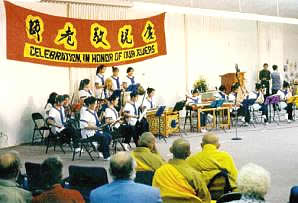
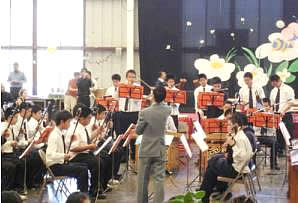
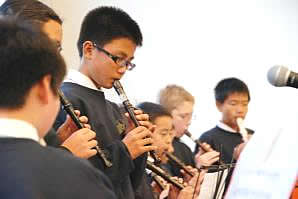
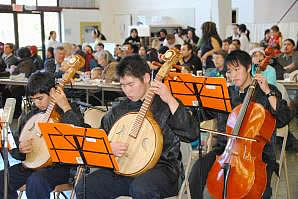
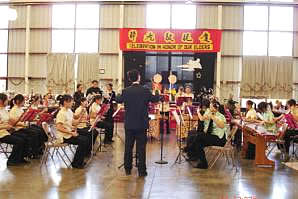
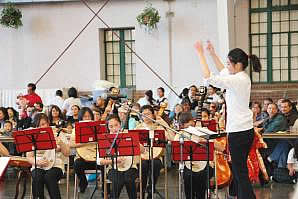


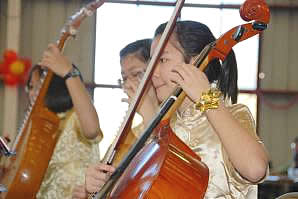
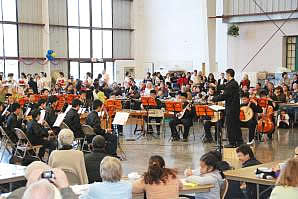

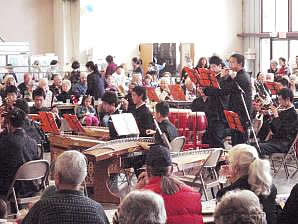
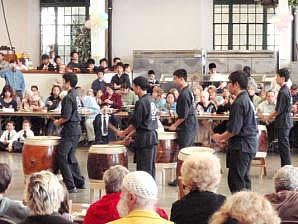
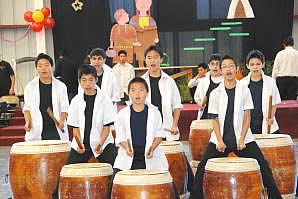

Celebrating Mother's Day 2014 (DVBS Orchestra & DVGS Orchestra)
Celebrating Mother's Day 2015
Celebrating Mother's Day audio
Chinese Orchestra Website
return to top

